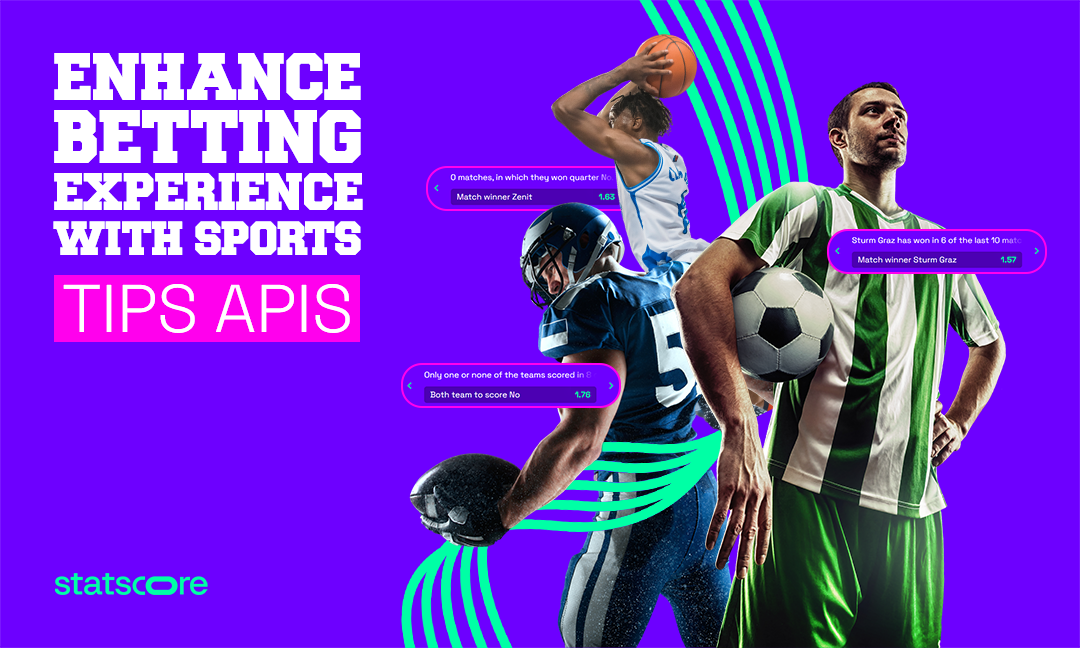Lance!, one of Brazil’s leading digital sports media platforms, is enriching its coverage of the ongoing Club World Cup with STATSCORE's data. Leveraging STATSCORE’s special edition of CupCenter’25, fully customized for the prestigious tournament, Lance! delivers an...
How real-time data is revolutionizing sports industry (and why it’s a must-have)

In the world of sports and sports business, live data has become the cornerstone of innovation, powering everything from smarter strategies on the field to more engaging fan experiences off it. For sports organizations, sportsbooks, and media companies, the ability to harness real-time statistics and insights isn’t just a competitive advantage – it’s a necessity.
How real-time sports data transforms sports organizations
For professional sports teams, real-time data has revolutionized various facets of their operations, including in-game decision-making, building strategies on the field and enhancing fan engagement.
Performance analytics for teams and athletes
The NFL teams, for example, use wearable devices and advanced analytics to track player performance metrics, such as speed, fatigue, and workload, as the game unfolds. This immediately available data enables coaches to make quick tactical adjustments, and drives their strategic decisions.
If a star player shows signs of exhaustion, a substitution can be made before performance declines. Similarly, analyzing live data allows defensive strategies to be altered mid-game, such as adjusting to counter an opponent’s passing patterns.
Tracking live statistics enables teams to adapt defensive or offensive strategies in real-time. If an opponent demonstrates a strong passing game, the defense can adjust immediately to counter specific patterns.

In baseball, the Moneyball strategy popularized by the Oakland Athletics demonstrates how advanced analytics have transformed team-building and in-game tactics. Using data to identify undervalued players based on metrics like on-base percentage (OBP), this approach proved that a strong, data-driven strategy can outperform traditional scouting methods, even with limited budgets. Today, real-time analytics complement this by offering live performance feedback, allowing teams to adapt in the moment.
Sports data is pivotal for strategic planning during games, as well as for preparing teams for upcoming ties. For example, basketball teams might alter their defensive setup based on a real-time assessment of their opponent’s shooting tendencies, while football coaches might switch formations mid-match to regain control of possession.
By analyzing live metrics such as possession, turnovers, or shooting accuracy, coaches can tweak game plans on the fly. All the data gathered during live game will also serve to better prepare the team for an upcoming game.
Data-boosted fan engagement strategies
The role of data in sports organizations doesn’t end with player performance and team analytics. In fact, real-time data plays a pivotal role in building connections with fans, as teams and leagues are integrating live statistics into their websites, apps and stadium displays, providing their supporters with deeper insights into every play.

During a basketball game, fans can access real-time shooting percentages, player stats, or even instant replays with overlaid data that highlight defensive matchups and shooting ranges. These features not only enhance the game-day experience but also create deeper emotional engagement by bringing fans closer to the action.
Whether it’s tracking a football team’s passing accuracy or a basketball’s player shooting performance, these data-driven experiences bring fans closer to the action, enhancing the overall engagement by keeping them in the loop.
Sports venues are increasingly adopting interactive displays and augmented reality (AR) features that allow fans to visualize player performance metrics, like sprint speed or pass completion rates, during football matches. This not only enriches the live experience but also fosters a sense of connection as fans feel part of the analytical journey.
Real-time sports data is also instrumental in delivering personalized experiences. Many teams use analytics to create tailored content for their fans, such as customized notifications about their favorite player’s achievements or milestones. Apps often include predictive tools, allowing fans to make predictions about the game’s outcome based on live data trends, further boosting their involvement.

There’s no doubt that real-time data has become a powerful tool for connecting with fans, creating more immersive and interactive experiences that deepen their loyalty and engagement. By integrating live statistics, insights, and dynamic visuals into websites, apps, broadcasts, and stadium displays, sports organizations offer fans unprecedented access to the intricacies of the game.
Attracting partners and sponsors
Real-time sports data not only enhances performance and fan engagement but also creates lucrative revenue streams for sports organizations, particularly through dynamic sponsorships.
By integrating data-driven solutions into their platforms, leagues and clubs can offer unique, customized advertising opportunities that appeal to sponsors seeking more targeted and impactful exposure.
For example, in match tracking solutions that can be employed on leagues’ or clubs’ platforms, such as the popular LivematchPro, customized ads can be used to promote partners and sponsors.

![]()
Get data-packed live sports tracker
Overall, the integration of real-time data into sports organizations has redefined how teams prepare, perform, and engage with their audiences. Whether it’s improving player performance, adjusting tactics on the fly, or enhancing the fan experience, real-time analytics have elevated the game at every level. As technology continues to evolve, the potential for even greater transformation in sports is limitless.
Sports data boosting sportsbooks revenues
For sportsbooks, real-time sports data is not just an operational necessity; it’s the key to creating a more engaging and dynamic betting experience.
Expanding the appeal of micro-betting
Micro-betting, where users bet on highly specific, short-term outcomes (such as the result of the next play in a football game or the number of points scored in the next basketball possession), is a revenue-boosting innovation for sportsbooks made possible by real-time data. These rapid betting opportunities appeal to a broader audience, particularly younger bettors who prefer immediate gratification and quick results.
One of the most significant ways real-time data has boosted sportsbook revenues is through the creation of dynamic, in-play betting markets. Bettors no longer have to place wagers solely before a game starts; they can now bet on outcomes as action unfolds. For example, during a football match, real-time data allows sportsbooks to offer bets on events like the next player to score, the number of corner kicks in the next 10 minutes, or the likelihood of a team mounting a comeback.

This flexibility encourages continuous engagement throughout the game, leading to higher volumes of wagers compared to traditional pre-game betting. As bettors interact with these fast-paced options, sportsbooks can capitalize on sustained interest, resulting in increased revenue.
Odds enhanced with live data
Real-time sports data enhances the accuracy of odds offered by sportsbooks. By analyzing live events and incorporating factors like player performance, injuries, weather conditions, and even crowd dynamics, sportsbooks can adjust their odds dynamically to reflect the current state of the game.
For instance, if a key player is unexpectedly injured, real-time data systems allow sportsbooks to immediately update odds to account for the impact on the team’s chances.
This capability is crucial in ensuring that sportsbooks remain agile and competitive, offering odds that accurately reflect the changing dynamics of the game. Without such updates, sportsbooks risk being exposed to significant financial losses as some bettors could exploit outdated odds.

Real-time odds updates also allow sportsbooks to capture additional betting volume by creating new markets tailored to the unfolding game scenario. If a football team’s top striker is substituted due to injury, sportsbooks can quickly introduce or update markets such as “next player to score”, keeping bettors engaged and driving more activity on the platform.
By responding dynamically to unexpected events, sportsbooks not only protect their financial interests but also deliver an interactive and satisfying experience that keeps users coming back.
High engagement through live sports data
Incorporating real-time data into sportsbook platforms helps create a more engaging and interactive experience. Advanced visualizations, live statistics, and instant updates allow bettors to stay informed and make smarter decisions.
Many sportsbooks integrate features such as live match trackers, pre-game widgets, and player stats into their apps or websites, providing bettors with the tools they need to feel more confident in their wagers.
Moreover, solutions such as automated live betting tips displayed on sportsbook’s websites and in apps are adjusted to show the most relevant data that is likely to inspire bettors to place another wager.
For example, when a red card is shown during a football game, users can receive a tip about the number of games of the affected team, in which more than one red card was given.

During a tennis match, bettors might receive a different actionable and contextual tip such as: “Player A won the last three tie-breaks in his matches”, which may lead them directly to a betslip where they can place their wager.
These instant live data-based predictions simplify the decision-making process for users, making betting more accessible and engaging, even for novice bettors.
Finally, live visualizations enhance the overall experience, allowing users to track every shot, corner, and goal while also seeing how these events influence betting markets. Platforms that integrate real-time data seamlessly, make live betting more immersive and intuitive than ever before.
The Role of Real-Time Data in Media Companies
Real-time sports data is transforming how media companies deliver sports coverage, enabling them to provide fast, accurate updates across multiple platforms. It supports them in creating an immersive and interactive experience that enhances viewer engagement.
Top sports coverage fueled with data
Media companies increasingly rely on real-time data to deliver fast, accurate, and engaging sports coverage, ensuring they remain trusted and relevant in a competitive landscape.
By harnessing the power of live data, media organizations provide fans with up-to-the-minute updates across multiple platforms, from mobile apps and websites to social media channels, especially during major events like the football World Championships.
Speed and accuracy in sports reporting are critical, and real-time sports data ensures that outlets can break news the moment it happens. Receiving live information, insights and statistics empowers outlets to break news the instant it happens, whether it’s a game-changing goal, a crucial substitution, or an unexpected injury.

Interactive features, such as match centers, live tracking of events on the field, detailed player stats, heatmaps and possession trackers, add further value for audiences.
Optimizing broadcast with live data
Boosting real-time broadcasts with data has become essential for TV companies looking to enhance viewer engagement and create a more immersive experience.
By seamlessly integrating live statistics, dynamic data, and insightful analysis, broadcasters can elevate their coverage, providing audiences with deeper context and a more interactive viewing experience.
For example, during a football match, broadcasters can overlay real-time stats such as possession percentages, shots on target, or player performance metrics directly onto the screen. This enables viewers to not only follow the game but also understand the nuances behind the team’s tactics and individual performances. Such insights go beyond what is captured through traditional commentary, providing fans with a richer, more informative broadcast.

Real-time data transforms traditional sports coverage into an interactive, insightful, and personalized experience. It allows broadcasters to provide more depth and excitement, encourages longer viewing times, and creates more opportunities for fan engagement and monetization. By adding layers of detailed statistics and dynamic content, media companies can not only inform viewers but also keep them engaged, making every broadcast more compelling and memorable.
Employing live data in fan engagement strategies
Live sports data provides media companies with a number of different engagement-building opportunities. For example, some of them are leveraging real-time data to create interactive and gamified content that keeps audiences active and entertained.
Live quizzes and prediction games have become one of popular tools for driving higher audience interaction.
A fan watching a football game online might be prompted with a question like, “Who will score the first goal in the second half?” Gamified experiences like these not only enhance the viewing experience but also generate additional revenue through sponsorships and advertisements.
By integrating these engaging features, media platforms encourage longer user sessions, boosting ad impressions and click-through rates. Additionally, the enhanced user experience strengthens subscription retention, as fans are more likely to stay loyal to platforms offering dynamic, value-added content tailored to their interests.
Sports data as a must-have
The sports industry operates in an environment where immediacy is paramount. Fans expect live updates, interactive experiences, and data-driven insights. Teams need actionable intelligence to make critical decisions mid-game. Sportsbooks depend on real-time information to remain competitive, while media outlets rely on it to maintain relevance in a fast-moving digital landscape.
Real-time data not only meets these demands but also unlocks new opportunities for engagement and revenue. Those who embrace this technology are not just keeping up – they are setting the pace.
For sports organizations, sportsbooks, and media companies, real-time data is no longer optional. It is the foundation of the future of sports.
ASK US HOW TO IMPLEMENT SPORTS DATA IN YOUR BUSINESS!
Related articles

Getting started with sports APIs – a beginner’s guide
Have you ever wondered how websites and apps deliver detailed sports stats and schedules so seamlessly? The answer lies in the power of sports APIs (Application Programming Interfaces). APIs are software intermediaries that enable different platforms to communicate...

Leveraging sports tips APIs to enhance betting experiences
Did you know that sportsbooks using real-time tips see significantly higher user retention? Betting platforms often struggle to keep users engaged and inspire repeat betting actions. However, integrating sports tips solutions can revolutionize user engagement by...

How can data boost sports coverage in media?
Today’s sports fans demand instant, accurate, and engaging coverage. They want real-time scores, player stats, and in-depth insights as the action unfolds. If they don’t get it, they’ll quickly move to another platform that delivers.Why Sports Data is Essential for...





